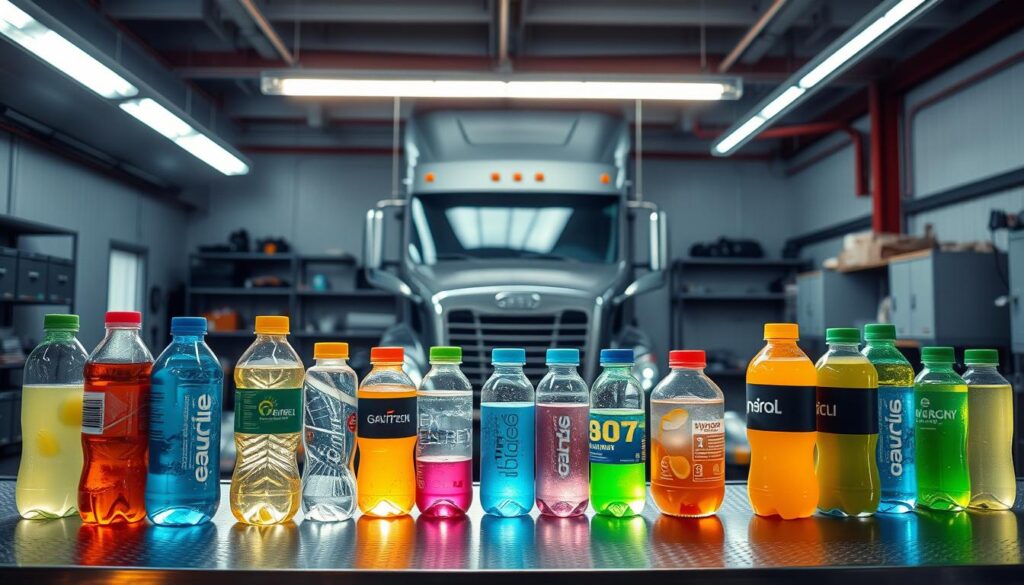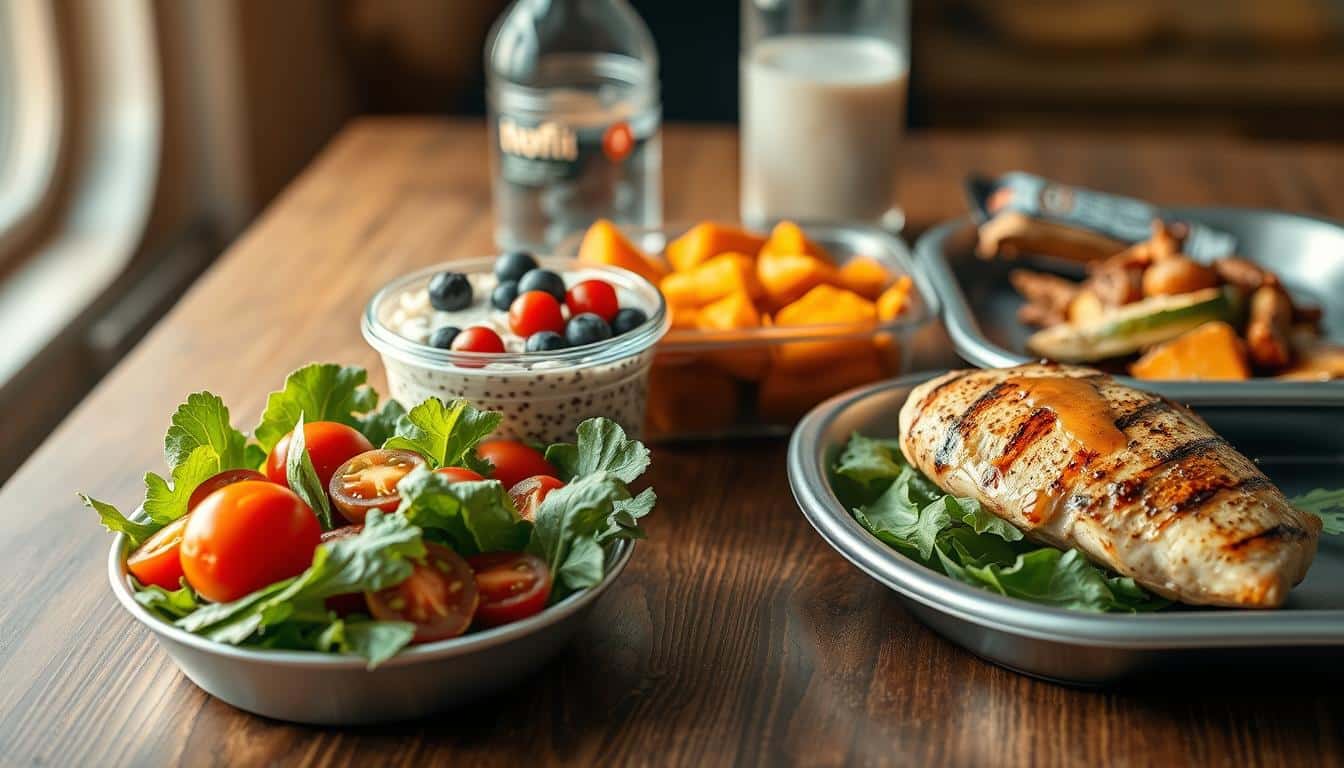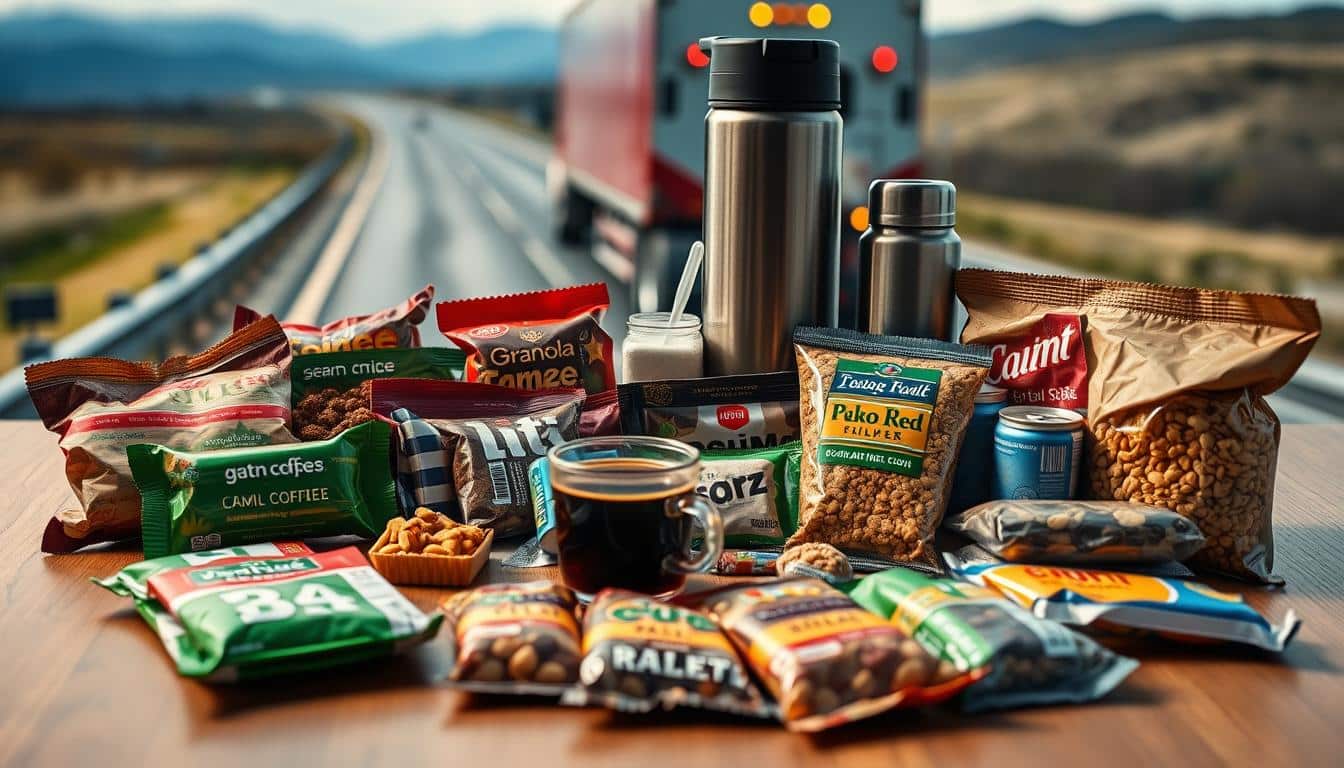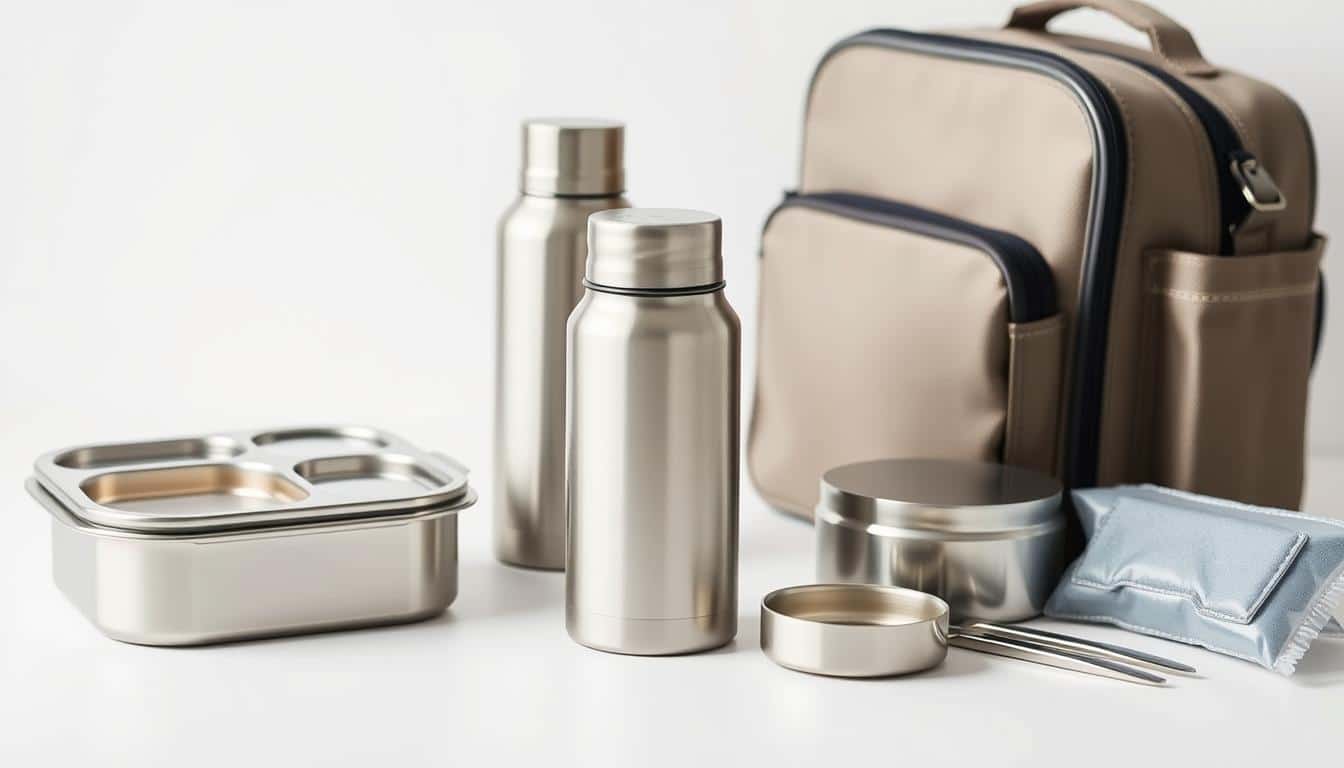This short guide shares easy meal tips for U.S. truck drivers. It offers realistic cooking ideas for those with little time and space. It’s perfect for drivers on long trips.
This article will show you how to prep meals. Doing this saves time and cuts down on unhealthy eating. It’s a good way to keep energy up without spending too much.
We’ll talk about handy tools like 12-volt appliances and portable coolers. You’ll learn about lunchbox cookers, slow cookers, thermoses, and small fridges too. Plus, get tips on smart eating, drink choices, and keeping your meals safe.
These tips come from experts and seasoned drivers. We pull ideas from sources like Nutrition for the Road: Quick and Easy Meal Preps. And we also include advice from 7 Food Prep Hacks For Truck Drivers. You’ll find useful steps for eating healthy on the road and great meal ideas for your next trip.
Why meal planning matters for truck drivers
Being on the road turns eating into a rushed act. A simple meal plan can fix this. It organizes long hours, controls hunger, and encourages eating well.
Truckers often face health challenges due to long, odd hours. Junk food at stops is usually full of calories, fats, and salt. Choosing this food often can lead to obesity, heart issues, and diabetes. Lack of sleep and being alone might also cause stress and sadness.
Experts suggest making small daily changes to stay healthy. Truckers who plan their meals avoid unhealthy fast food. Pre-making meals leads to better health and energy for the journey.
Packing meals in advance is smart and convenient. It helps drivers save money by avoiding expensive stops. Cooking in batches and using the freezer reduces meal costs and saves time.
Planning means drivers control what they eat. By doing so, they reduce unhealthy choices and spontaneous buys at stops.
- Start small: plan one meal or one day to build confidence.
- Pre-portion into containers to prevent mindless snacking.
- Keep a short shopping list of batch-cook staples for the week.
This approach helps truckers avoid health issues and save money while on the road. Meal planning turns irregular eating into healthy, predictable habits that fit a truck cab lifestyle.
Essential cab kitchen gear for easy trucker meal hacks
Having the right tools in your sleeper cab makes eating healthy easy and stress-free. These items help by saving time, reducing waste, and are perfect for small spaces. Choose gear that fits your truck’s power and layout to have a good trip.
Portable refrigeration and coolers
Start by picking a trustworthy cooler or a small 12-volt fridge. This helps keep things like milk, fruits, and meats fresh. A fridge that connects to your truck keeps foods cold, preventing spoilage.
Put drinks and snacks in the fridge’s back to avoid sugary temptations. Go for brands like Dometic or ARB for long-lasting use in your cab.
Cooking gadgets that work in a cab
Look for cab cooking gadgets that fit your truck’s power. Tools like lunchbox cookers and portable slow cookers let you cook healthy meals. They don’t need a big kitchen.
Crock-Pot travel sizes and small hotplates are good, if allowed. Choose devices suited for trucks or those that use little power to protect your batteries.
Storage and organization tools
Good storage solutions keep your food safe and cab neat. Use sealed containers and freezer bags for meals and snacks. This helps with cleanliness and organization.
- Ziplock bags for pre-portioning snacks and ingredients
- Airtight plastic or glass containers for refrigeration
- Stackable shelving or hanging organizers to separate food from bedding
Keeping things tidy prevents spills and keeps your cab smelling nice. Use containers with secure lids and choose foods with light smells for a better living area.
Smart shopping strategies for long hauls
Shopping wisely makes road life simpler. Aim to plan for 10–14 days, but reduce if needed. Have a brief list and follow it to skip impulse buys. Look for foods that last long, store easily, and provide energy for truck drivers.
Choose foods like raw nuts, beans, brown rice, and fruits. They offer lasting energy. Snacks high in fiber like roasted chickpeas and almonds help you stay full. They also avoid sleepiness after eating.
How to read labels at quick stops
Learn to quickly read food labels during short stops. Pick items with few ingredients, such as “peanuts, salt” for peanut butter. Look at sodium and sugar content. Avoid foods with complex chemical names.
- Search for items with low sodium and no added sugar.
- Opt for foods with single ingredients or readable mixes.
- Stay away from items with hydrogenated oils or long lists of artificial ingredients.
Buying frozen and shelf-stable staples
Frozen fruits and veggies keep nutrients and fit in small freezers. Rotate frozen staples like vegetables, fruits, and meals for reheating. Shelf-stable proteins like tuna, beans, and nuts are great backups.
Divide pre-made meals into smaller parts and freeze again to last longer. Purchase versatile basics like rice, wraps, and tomatoes. These can create various meals. When buying for truck drivers, mix fresh and frozen items. This approach reduces waste and adds variety.
Produce aisle snacks and simple shopping tips
Fruits like apples and bananas are perfect for travel. Keep nuts and seeds for filling snacks. Start with a few items if you’re new to this. Then, try different seasonings on the same protein to vary taste.
- Create a 2-week shopping list including fresh, frozen, and pantry items.
- Change up proteins and seasonings to keep meals interesting.
- First fill your cart with high-fiber snacks and simple ingredient foods.
Batch cooking and meal-prep templates for truck drivers
Batch cooking saves truckers time and reduces mess. Spend a few hours on the weekend prepping meals for the week. It’s smart to follow meal-prep templates for organized cooking and easy shopping.
Batching basics to save time and dishes
Cook big batches of protein and grains to save time. This method makes mealtime quick and easy. Slow cook dishes like chili to cut down on cleaning.
Versatile base ingredients and repurposing ideas
Choose versatile ingredients that work in many dishes. Use roasted chicken in salads, wraps, and more. Grains and veggies can also be remixed into different meals.
- Meal idea: shredded chicken → tacos, grain bowls, and shredded-salad jars.
- Grain idea: quinoa → pilaf, cold salads, or stuffed tomatoes.
- Veg idea: roasted veggies → sides, omelets, or blended into soups.
Freezer- and fridge-friendly prep plan
Focus on meals that freeze well, like casseroles. Make sure to label everything clearly. Store salads in mason jars to keep them fresh and ready.
Balance raw and cooked foods to keep things interesting. Keep veggies and snacks separate from warm meals. Using rotation and labeling makes meals convenient and reduces waste.
Keeping track of what you have is easy with labels and templates. This helps you stay flexible with your meals, especially when using the freezer.
Breakfast hacks to start the day energized
Starting your morning on the road? Keep it simple. Focus on protein and fiber to stay energized during your drive. With a cooler and some basic containers, keeping your meals fresh and accessible is a breeze.
Quick make-ahead breakfasts
Prepping breakfast ahead saves early morning hassle. Combine eggs, roasted veggies, and cheese in a dish to slice later. Or, make burritos, wrap them in foil, and freeze. They’re quick to reheat at a truck stop.
- Muffins packed with oats, nuts, and banana offer a tasty, fibrous, on-the-go snack.
- Homemade energy bars mix oats, peanut butter, and dried fruit for an energy boost.
- Boil eggs and keep them in your cooler for a quick, high-protein snack.
Thermos and no-reheat options
A thermos can keep your meals hot for hours, perfect for skipping the reheat stage. Fill it with oatmeal, stew, or soup. For cold meals, pack yogurt with granola, fruit cups, sandwiches, and chilled hard-boiled eggs.
- Bag your smoothie ingredients. When you find a blender, you’re all set.
- Keep your parfaits fresh in sturdy containers to avoid a mushy breakfast.
- Vary your routine with both thermos meals and cold items to keep mornings interesting.
Eat foods rich in protein and fiber to avoid getting hungry too soon. These breakfast ideas are designed for truckers. They are easy, tasty, and keep your energy up without too many stops.
Snack portioning and better road snacking
Long drives often turn snacking into a regular habit. Thoughtful portioning changes impulsive eating into consistent energy sources. Use small bags and clear containers to keep trucker snacks visible and ready for when hunger strikes.

Pre-portioning to prevent mindless eating
Before you hit the road, divide chips, nuts, and trail mix into single-serve bags. This prevents you from digging into a full bag. It aids in controlling portions and tracking calories effortlessly.
Mark packets by day or meal. Place frequently used snacks at eye level in your cooler or bin. Keeping sugary snacks at the back reduces temptation during long drives.
High-satiety snack choices
Opt for snacks that mix protein and fiber. Foods like raw almonds, Greek yogurt, hard-boiled eggs, and hummus with carrots keep you full. They lower cravings and help you skip unnecessary stops.
- Trail mix with minimal added sugar
- Cheese with whole-grain crackers
- Fresh fruit: apples, bananas, berries
- Protein packs or single-serve nut butter
Choose snacks like unsalted or lightly salted nuts to prevent extra thirst and overeating. Smaller, well-planned portions satisfy hunger, making healthy snacks an easy pick on the road.
Easy lunch and dinner builds for the cab
Make your midday and evening meals simple, balanced, and quick. Choose food that can stay fresh in a cooler and is easy to mix in the cab. Small prep steps before you hit the road can open up many options for eating well.
Jar salads keep things fresh with layers. First goes the dressing, then crunchy veggies and grains, with greens on top. Mason jars help control portions and reduce prep time during stops.
- Layer dressing, beans or chickpeas, cooked quinoa, chopped peppers, and baby spinach for a grab-and-go jar salads option.
- Add sliced chicken, canned tuna, or pre-sliced turkey for added protein without reheating.
Protein bowls are a great way to mix grains, veggies, and protein into one tasty meal. Prepare grains like brown rice in large amounts and keep them ready in containers.
- Mix pre-cooked rice, black beans, corn, diced avocado, and salsa for a simple protein bowls meal.
- Top with a hard-boiled egg or canned salmon to boost satiety and nutrition.
Wraps and cold sandwiches are great when you can’t use a microwave. Choose whole-wheat tortillas and fill them with hummus, sliced turkey, and fresh veggies to keep things from getting soggy.
Slow-cooker meals are perfect for starting at home or at company lots before long trips. A trucker’s slow cooker can make chili, pulled pork, or stew that’s easy to serve later.
- Cook chili with lean ground turkey and beans, then cool and pack in single-serve containers.
- Prepare BBQ chicken in a Crock-Pot, shred, and use for sandwiches or protein bowls later in the week.
Stoveless dinners can be a real time-saver when you’re on a tight schedule. Options like tuna pouches, ready-made protein packs, and salad kits don’t need heating. This keeps dinner quick and healthy even after a long day on the road.
- Combine tuna, pre-washed greens, and a squeeze of lemon for a zero-heat meal.
- Keep single-serve hummus, carrot sticks, and whole-grain crackers for a balanced stoveless dinners option.
Choosing low-effort reheating methods can save time at stops. Use microwaves where allowed, keep soups hot in thermoses, or use a portable cooker if you can. Cold slices of protein work well in salads or wraps when you can’t reheat.
- Reheat pre-made quesadillas or stir-fry portions at a microwave for a fast, satisfying meal.
- Store soups in an insulated thermos to keep them hot for hours and skip the stop-and-heat routine.
Mixing jar salads, protein bowls, and wraps keeps meals interesting and cuts down on waste. Taking a few extra steps in prep can turn cab lunches into a pleasant break instead of a rushed necessity.
Hydration and beverage hacks to reduce empty calories
Keeping it simple with drinks really helps on long trips. Making small changes can reduce sugar and improve focus. It’s easier to pick healthy drinks on the go with the right tools and habits.

Best beverage choices on the road
- Water is the best choice. Have a refillable bottle to fill up at stops or cafes, keeping hydration up.
- Try unsweetened iced tea or sparkling water for a change without sugar.
- Choose black coffee from places like Starbucks or Dunkin’ to avoid added sugars and creams.
- Use low-sugar electrolyte mixes sparingly after sweating a lot. They help replace salts without extra calories.
How to avoid sugary traps at truck stops
- Look at labels before you buy. Choose drinks with less ingredients and no added sugar to cut down on empty calories.
- Keep sugary drinks at the back of your cooler. This way, you’ll reach for healthier options first.
- Avoid flavored creamers and fancy coffees. Ask for regular milk or a little half-and-half to keep sugar and fat in check.
- Select snacks that go well with water or unsweetened tea to avoid sugar cravings from drinks.
Little changes make a big difference. Drinking water often and choosing healthier drinks can keep your energy level more constant. These habits cut down on empty calories. They make long drives easier and help you stay focused.
Food safety and storage tips for truckers
Planning and simple habits are key to keeping food safe on the road. Truck drivers face challenges in controlling temperature and keeping their equipment clean. By following practical routines, they can protect their meals and lower the chance of getting sick.
Temperature control and perishables
- It’s smart to use 12-volt coolers or compact fridges in trucks. This helps keep perishable foods at 40°F (4°C) or below, which is safe.
- Freezing items that can be stored long-term is wise. Always rotate your food based on the date and label prepared meals clearly.
- Throw away perishables if the power goes out or the temp goes too high for over two hours.
- Hot foods need to stay at 140°F (60°C) or more. Use tightly sealed thermoses to keep them warm until eating.
Sanitation and minimizing contamination
- Keeping your cab clean for food is something to do daily. Clean your hands with soap or sanitizer before touching food.
- Keeping foods in clean, sealed containers separates raw meats from other foods. Using different cutting boards also avoids cross-contamination.
- After using them, always clean your surfaces and utensils. Clean up spills right away and use sanitizing wipes or bleach solution.
- When you can’t wash things well, pre-cooked or sealed foods are best.
Practical tips for safe meals on the road
- Always use portable cooking appliances as their instructions say. This prevents undercooking.
- Keeping a thermometer in your cooler or fridge lets you check the temperature every day.
- If you’re not sure a food item is safe, it’s best to toss it. This keeps you safe from foodborne illnesses on long trips.
- Create a simple checklist. Include things like checking the fridge, keeping the cab clean, and rotating meals before each trip.
Trucker meal hacks
Making small changes in how you prepare and pack can make a big difference. These easy steps can help you cut down on stops, save money, and eat healthier. Here, you’ll find useful tips, a weekly meal plan, and a packing list that will make your meals enjoyable and simple.
Easy, actionable hacks to implement today
- Divide snacks into small bags. This controls portions and makes them easy to grab.
- Place sugary drinks in the back of the fridge. This makes healthier choices more visible.
- Start by preparing one meal or enough for a week before a trip to build a routine.
- Keep soups and oatmeal in a thermos, and opt for meals that don’t need reheating, like wraps.
- Cook proteins and grains in large batches. Then, simply change the sauces for different flavors.
- Have frozen fruits and veggies ready for smoothies or quick side dishes.
- When you have access to power, use a Crock-Pot for effortless meals either on the road or at home.
Sample weekly rotation
Having a set of basic meals each week can help you save time and money. Here’s a weekly plan you can tweak to keep things interesting.
- Breakfast options include egg-bake slices, muffins, or boiled eggs with fruit.
- For lunch, try mason-jar salads, turkey wraps, or bowls with quinoa and chicken.
- Dinner could be slow-cooker chili, reheated casseroles, or stoveless meals like tuna or veggie burgers.
- Snacks: Think about pre-portioned nuts, apple slices, cheese with crackers, or trail mix.
Time-saving packing checklist
Keep this meal prep list handy. It will make packing faster and ensure you don’t forget anything important.
- A 12-volt cooler or fridge, plus a portable cooker or Crock-Pot for longer trips.
- Pack a thermos, containers with tight lids, zip-top bags, mason jars, labels, and a marker.
- Bring along pre-portioned snacks, frozen produce, and pre-cooked proteins and carbs.
- Don’t forget utensils, a small cutting board, hand sanitizer, wipes, and trash bags.
- Include a reusable water bottle and an insulated coffee mug to save on stops and reduce waste.
To minimize stops, save money, and eat well on the road, use the meal prep checklist and rotate your meals weekly. Adjust the quantities based on your route and available fridge space to get the best results.
Conclusion
This summary gives truckers actionable meal tips. It covers meal planning, batching, portion control, and high-fiber foods to save money and lower health risks. Use a thermos, a 12V cooler, a Crock-Pot, and airtight containers. These make meal prep easy and doable on the road.
Start with a small step: prepare a breakfast or a week of lunches. This builds confidence and a routine. It also cuts down on costly truck-stop meals. Drinking enough water and choosing healthy drinks helps keep your energy up and cuts down on junk food.
Keep food safe and at the right temperature on long trips. Doing this leads to regular meals, steady energy, and less health risk in the long run. The tips here come from Nutrition for the Road. They include fiber and drink suggestions and batch-prep ideas like using a Crock-Pot.
Begin with easy steps, and choose simple meals. This way, meal planning on the go becomes a good habit. It saves money and makes life on the road better.
FAQ
Why does meal planning matter for truck drivers?
What are the main health risks of life on the road?
How does prepping food save money and time?
What portable refrigeration options work in a cab?
Which cooking gadgets are safe and practical for a truck cab?
What storage and organization tools should I pack?
How do I choose higher-fiber, minimally processed foods on the road?
How can I read labels quickly at quick stops?
What frozen and shelf-stable staples should I buy?
What are batching basics to save time and dishes?
How can I repurpose base ingredients to avoid boredom?
What meals freeze and reheat best for long hauls?
What quick breakfasts work on the road?
When should I use a thermos or choose no-reheat options?
How do I pre-portion snacks to avoid overeating?
What are high-satiety snack choices for long drives?
What are easy lunch and dinner builds for the cab?
Which slow-cooker recipes work well for batch meals?
How can I reheat meals with minimal effort in a truck?
What are the best beverage choices to avoid empty calories?
How can I avoid sugary traps at truck stops?
How should perishables be stored and temperature-controlled in a cab?
What sanitation steps prevent foodborne illness on the road?
What simple hacks can I implement today to eat better on the road?
Can you give a sample weekly rotation for truck drivers?
What should be on my time-saving packing checklist?
Content created with the help of Artificial Intelligence.



